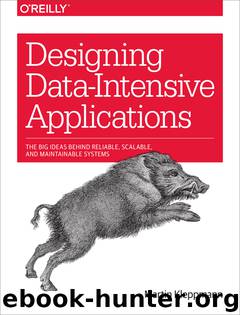Designing Data-Intensive Applications by Kleppmann Martin

Author:Kleppmann, Martin
Language: eng
Format: epub
Publisher: O'Reilly Media Inc.
Published: 2017-03-17T04:00:00+00:00
Multi-leader replication (not linearizable)
Systems with multi-leader replication are generally not linearizable, because they concurrently process writes on multiple nodes and asynchronously replicate them to other nodes. For this reason, they can produce conflicting writes that require resolution (see “Handling Write Conflicts”). Such conflicts are an artifact of the lack of a single copy of the data.
Leaderless replication (probably not linearizable)
For systems with leaderless replication (Dynamo-style; see “Leaderless Replication”), people sometimes claim that you can obtain “strong consistency” by requiring quorum reads and writes (w + r > n). Depending on the exact configuration of the quorums, and depending on how you define strong consistency, this is not quite true.
“Last write wins” conflict resolution methods based on time-of-day clocks (e.g., in Cassandra; see “Relying on Synchronized Clocks”) are almost certainly nonlinearizable, because clock timestamps cannot be guaranteed to be consistent with actual event ordering due to clock skew. Sloppy quorums (“Sloppy Quorums and Hinted Handoff”) also ruin any chance of linearizability. Even with strict quorums, nonlinearizable behavior is possible, as demonstrated in the next section.
Download
This site does not store any files on its server. We only index and link to content provided by other sites. Please contact the content providers to delete copyright contents if any and email us, we'll remove relevant links or contents immediately.
Algorithms of the Intelligent Web by Haralambos Marmanis;Dmitry Babenko(8588)
Building Statistical Models in Python by Huy Hoang Nguyen & Paul N Adams & Stuart J Miller(7515)
Azure Data and AI Architect Handbook by Olivier Mertens & Breght Van Baelen(7511)
Serverless Machine Learning with Amazon Redshift ML by Debu Panda & Phil Bates & Bhanu Pittampally & Sumeet Joshi(7389)
Driving Data Quality with Data Contracts by Andrew Jones(7145)
Data Wrangling on AWS by Navnit Shukla | Sankar M | Sam Palani(7144)
Machine Learning Model Serving Patterns and Best Practices by Md Johirul Islam(6869)
Learning SQL by Alan Beaulieu(6192)
Weapons of Math Destruction by Cathy O'Neil(6116)
Big Data Analysis with Python by Ivan Marin(5835)
Data Engineering with dbt by Roberto Zagni(4842)
Solidity Programming Essentials by Ritesh Modi(4471)
Time Series Analysis with Python Cookbook by Tarek A. Atwan(4305)
Pandas Cookbook by Theodore Petrou(4009)
Blockchain Basics by Daniel Drescher(3475)
Natural Language Processing with Java Cookbook by Richard M. Reese(3050)
Hands-On Machine Learning for Algorithmic Trading by Stefan Jansen(3010)
Feature Store for Machine Learning by Jayanth Kumar M J(2898)
Learn T-SQL Querying by Pam Lahoud & Pedro Lopes(2865)
